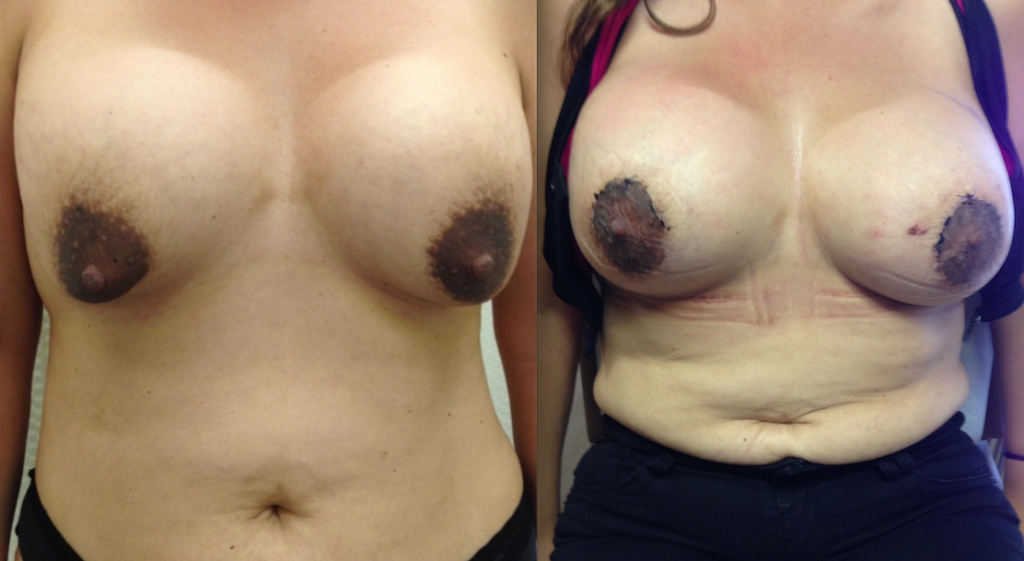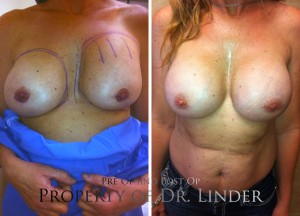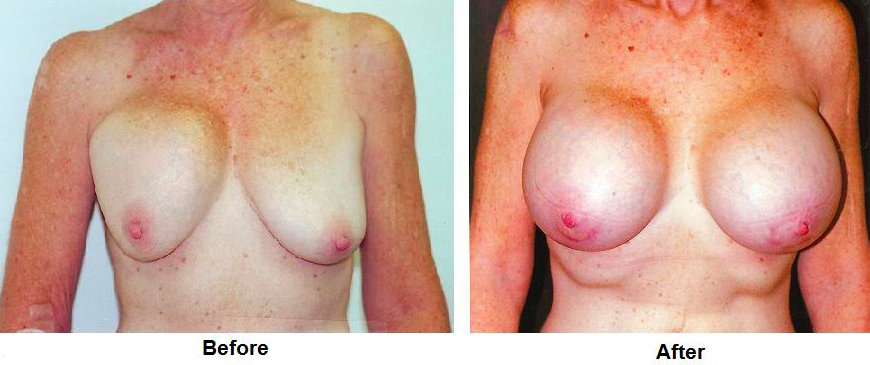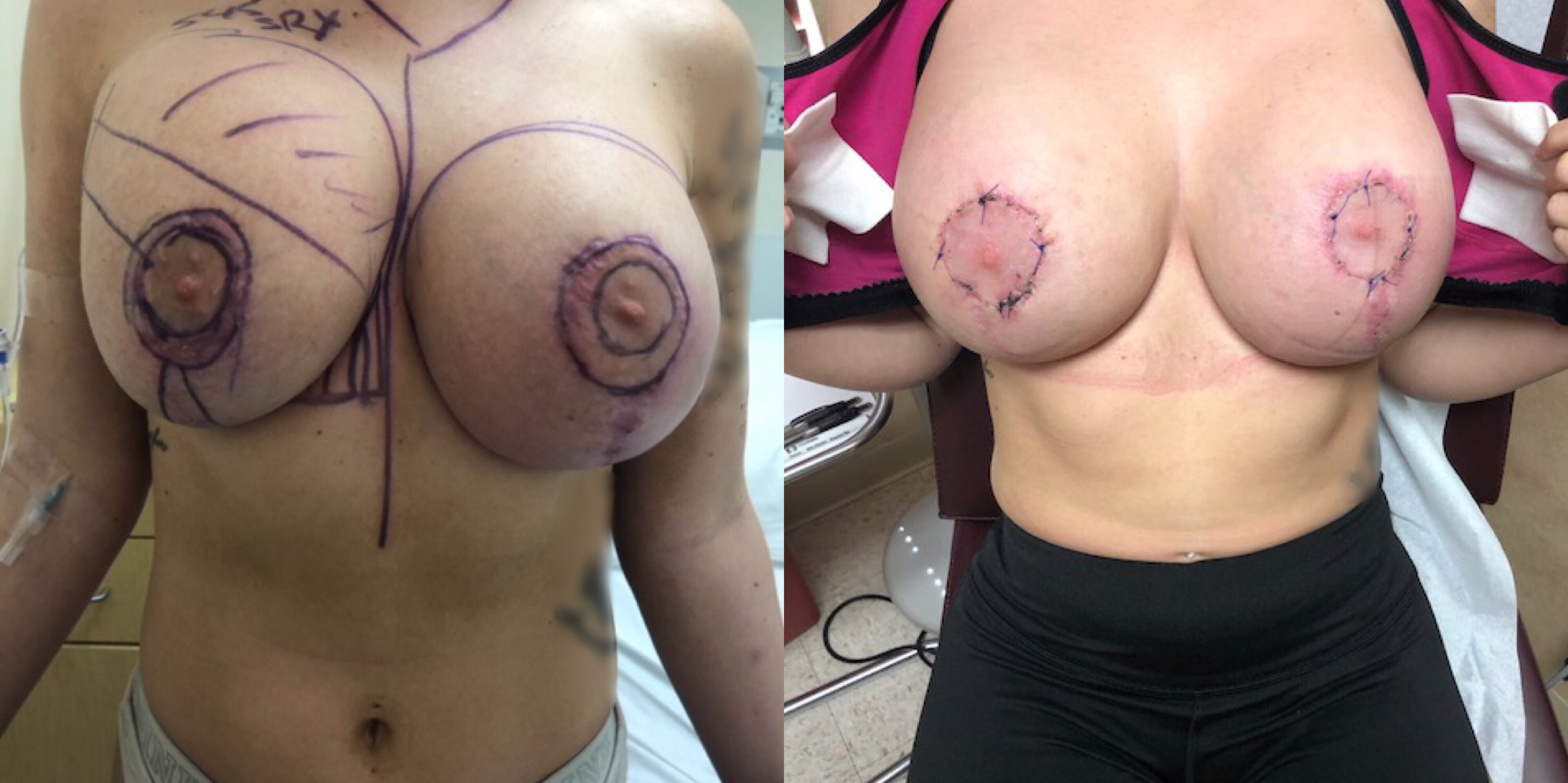Correcting Double Bubble Breast Deformities
Posted On: July 26, 2018 Author: The Office of Dr. Stuart Linder Posted In: Breast Implants, Capsular Contracture, Double Bubble Breast Deformity
Severe Double Bubble Deformity
There are two types of double bubble deformities that are primarily distinguishable by their placement within the breast. The upper pole double bubble appears above the nipple, most likely due to the implant being in a relatively high position in the breast. The other is called lower pole double bubble (known as bottoming out), which is under the breast near the inframammary crease. This lower pole occurs when the implant moves down with the breast, creating a secondary crease. In many cases, the longer a double bubble breast deformity goes uncorrected, the more severe the deformity becomes. Listed below are four cases of patients who underwent breast revision surgery to correct a double bubble deformity.
Learn More About Breast Revision Surgeries
Case Study #1
 This is an excellent case example of a patient with severe encapsulated superior retropositioned implants with a double bubble deformity with an overhanging of the nipple-areolar complex. She desired reconstruction, however, declined any significant scarring, including inverted T. I decided upon a bilateral periareolar lift with complete release of the parasternal muscle attachments and inferior displacement of the implants through a total open capsulectomy. Her post-operative results of three weeks show excellent healing and bilateral repositioning of the nipple. She continues to wear an upper pole compression band. Sutures were removed three weeks post-op, and she continues to wear the Dr. LinderBra™ for six weeks. Notice the reshaping of the breast without a lift or an inverted T, but simply due to the superior periareolar lift and repositioning of the implant to its proper position, the nipples now show some white underneath the areolar, which indicates good placement of the nipple-areolar complex.
This is an excellent case example of a patient with severe encapsulated superior retropositioned implants with a double bubble deformity with an overhanging of the nipple-areolar complex. She desired reconstruction, however, declined any significant scarring, including inverted T. I decided upon a bilateral periareolar lift with complete release of the parasternal muscle attachments and inferior displacement of the implants through a total open capsulectomy. Her post-operative results of three weeks show excellent healing and bilateral repositioning of the nipple. She continues to wear an upper pole compression band. Sutures were removed three weeks post-op, and she continues to wear the Dr. LinderBra™ for six weeks. Notice the reshaping of the breast without a lift or an inverted T, but simply due to the superior periareolar lift and repositioning of the implant to its proper position, the nipples now show some white underneath the areolar, which indicates good placement of the nipple-areolar complex.
Patients with severe double bubble breast deformity can have periareolar lifts without inframammary scars if they are the correct candidate.
Case Study #2
 The patient presents with severe Baker IV capsular contracture with a left double bubble breast deformity with superior retroposition of the left implant causing a very unnatural appearance of her breast as well as severe pain. The patient has increasing pain in the left breast with swelling that is consistent with seroma-induced capsular contracture, subsequently leading to superior retropositioning of the left implant that causes a double bubble breast deformity. She also had inadequate release of the attachments of the pectoralis major muscle along the parasternal ridge and the lateral inframammary fold. Postoperative photographs show high profile saline implant replacement with left open periprosthetic capsulectomy, removal of fluid seroma, and complete release of the parasternal and the lateral inframammary attachments of the pectoralis major muscle. The symmetry is now good. The upper pole fullness is even, and the inframammary folds are in proper position. This photo is approximately six weeks after surgery.
The patient presents with severe Baker IV capsular contracture with a left double bubble breast deformity with superior retroposition of the left implant causing a very unnatural appearance of her breast as well as severe pain. The patient has increasing pain in the left breast with swelling that is consistent with seroma-induced capsular contracture, subsequently leading to superior retropositioning of the left implant that causes a double bubble breast deformity. She also had inadequate release of the attachments of the pectoralis major muscle along the parasternal ridge and the lateral inframammary fold. Postoperative photographs show high profile saline implant replacement with left open periprosthetic capsulectomy, removal of fluid seroma, and complete release of the parasternal and the lateral inframammary attachments of the pectoralis major muscle. The symmetry is now good. The upper pole fullness is even, and the inframammary folds are in proper position. This photo is approximately six weeks after surgery.
Case Study #3
 Below is an excellent case of a patient who has undergone bilateral breast reconstruction for breast cancer mastectomy. The left implant had ruptured, and the right implant shows a severe double bubble breast deformity with superior retropositioning of the implant. Her surgery was performed by a different surgeon approximately 12 years ago. She has had increasing scar tissue on both breasts leading to complete rupture of the left implant. The right implant has taken on a very odd shape, it is deformed and shows a severe Baker IV capsular contracture. The post-operative photograph shows bilateral open periprosthetic capsulectomy, circumferential open capsulotomy and removal, and replacement with high profile saline implants. After three and a half months, the patient’s implants have fallen to a reasonable level, and she is pleased with her final appearance.
Below is an excellent case of a patient who has undergone bilateral breast reconstruction for breast cancer mastectomy. The left implant had ruptured, and the right implant shows a severe double bubble breast deformity with superior retropositioning of the implant. Her surgery was performed by a different surgeon approximately 12 years ago. She has had increasing scar tissue on both breasts leading to complete rupture of the left implant. The right implant has taken on a very odd shape, it is deformed and shows a severe Baker IV capsular contracture. The post-operative photograph shows bilateral open periprosthetic capsulectomy, circumferential open capsulotomy and removal, and replacement with high profile saline implants. After three and a half months, the patient’s implants have fallen to a reasonable level, and she is pleased with her final appearance.
Case Study #4
 The pre-op photo shows a severe double bubble deformity. The patient’s right breast has a Baker IV capsular contracture, which is pushing the muscle to a superior retroposition that causes a very unnatural appearance. The reason for this is due to the muscle contracting and causing the implant to push upward.
The pre-op photo shows a severe double bubble deformity. The patient’s right breast has a Baker IV capsular contracture, which is pushing the muscle to a superior retroposition that causes a very unnatural appearance. The reason for this is due to the muscle contracting and causing the implant to push upward.
This patient had a primary augmentation one year ago by another surgeon, and she was hoping to correct her asymmetry. After listening to her expectations, we agreed to schedule a breast revision surgery date.During the surgery, I performed a capsulectomy by removing the implants and scar tissue, which is the capsule around the implant, and I replaced them with 545 cc silicone gummy bear implants. I also lifted the breast to ensure a youthful appearance.The post-op photo was taken two weeks after surgery, and she is healing well with symmetrical breasts. She will be wearing a compression bra for the next few weeks to help maintain the positions of the implants as she recovers.Only breast revision surgeries such as these should be performed by board-certified plastic and reconstructive surgeons who have experience and judgment to perform these difficult operations.